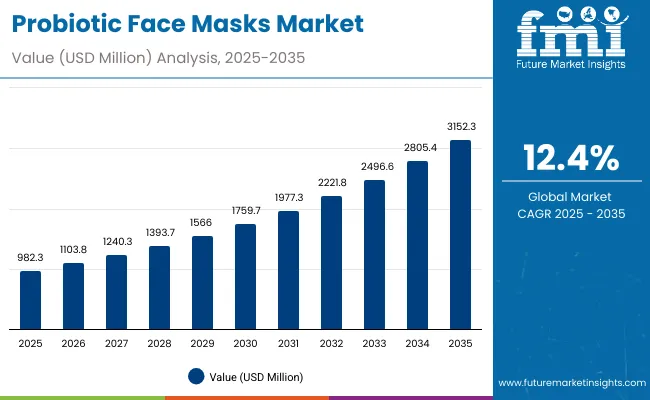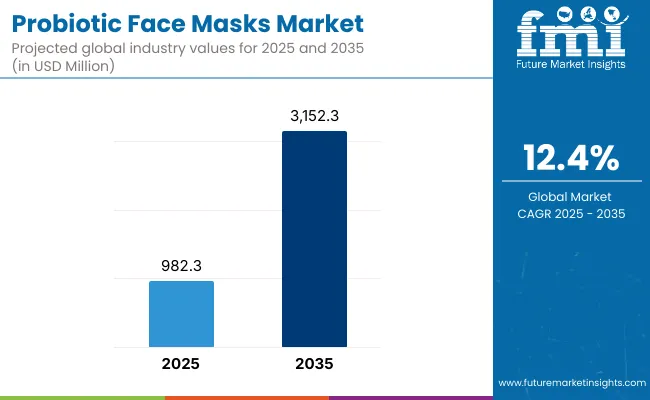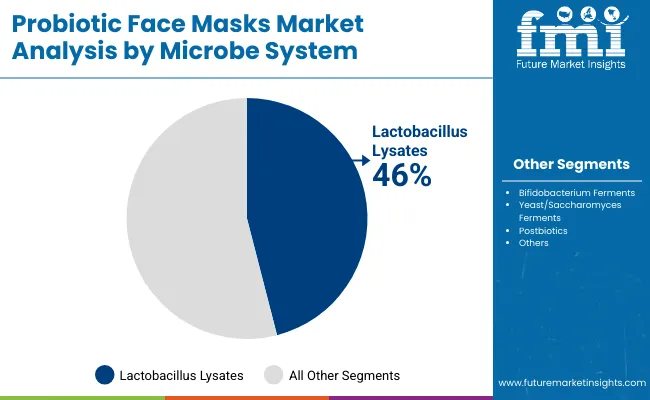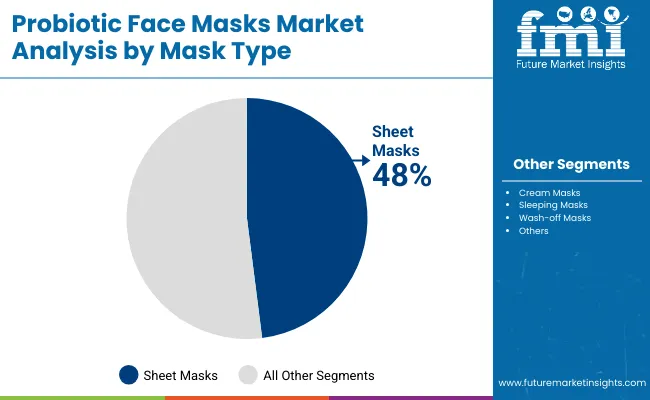A valuation of USD 982.3 million has been projected for the probiotic face masks market in 2025, with growth anticipated to reach USD 3,152.3 million by 2035. This expansion reflects an increase of USD 2,170.0 million over the decade, equal to more than a threefold rise in market value. The projected growth corresponds to a CAGR of 12.4%, underscoring a strong trajectory supported by rising consumer awareness of skin microbiome care and the widespread integration of probiotic formulations into beauty regimes.


Probiotic Face Masks Market Key Takeaways
| Metric | Value |
|---|---|
| Probiotic Face Masks Market Estimated Value in (2025E) | USD 982.3 million |
| Probiotic Face Masks Market Forecast Value in (2035F) | USD 3,152.3 million |
| Forecast CAGR (2025 to 2035) | 12.40% |
Between 2025 and 2030, the market is forecasted to grow from USD 982.3 million to USD 1,759.7 million, contributing USD 777.4 million to the decade’s total expansion, or 35.8% of overall growth. This phase is expected to witness steady adoption, supported by greater preference for natural skincare, higher digital distribution through e-commerce, and strong engagement from younger consumer groups. Barrier-strengthening formulations, holding 55.0% share in 2025, are anticipated to dominate this period, as demand for restorative skincare gains further traction.
The second half of the forecast, from 2030 to 2035, is expected to deliver faster gains of USD 1,392.6 million, representing 64.2% of total growth, as the market rises from USD 1,759.7 million to USD 3,152.3 million. This momentum is projected to be fueled by increasing clinical validation, deeper penetration into emerging Asian markets, and sustained premiumization of probiotic skincare. By 2035, Lactobacillus lysates are anticipated to remain the leading microbe system with 46.0% share, supported by evidence-driven consumer trust.
From 2020 to 2024, probiotic-based skincare was steadily established as a premium segment within the broader face masks category. Growth was primarily driven by heightened consumer awareness of microbiome health and the introduction of clinically validated formulations. During this period, niche innovators were observed to shape competitive momentum, while digital-first distribution accelerated early adoption across both Asia and North America.
By 2025, the market is anticipated to expand further, achieving USD 982.3 million in value, supported by demand for barrier-strengthening and sensitive-skin solutions. Looking forward, the revenue base is projected to more than triple by 2035, with Asia-Pacific expected to deliver significant incremental gains.
Established players are predicted to adapt by scaling innovation pipelines and strengthening claims credibility, while new entrants are expected to leverage transparency, digital channels, and consumer-centric storytelling. Competitive advantage is projected to shift toward clinically proven outcomes, sustainability positioning, and multi-functional innovation rather than product proliferation alone.
Growth in the probiotic face masks market is being driven by heightened consumer awareness of skin microbiome health and the rising demand for natural, functional skincare. Increased sensitivity to environmental stressors has created strong interest in formulations that strengthen the skin barrier, a segment expected to dominate throughout the forecast period.
E-commerce expansion has facilitated wider accessibility, enabling brands to reach diverse consumer groups and accelerate adoption across global markets. Clinical validation of probiotic ingredients is being emphasized, which is expected to build trust and reinforce long-term consumer engagement.
Younger demographics are showing strong inclination toward clean-label, vegan, and fragrance-free solutions, fueling innovation pipelines. Premiumization trends are being observed, with leading players expanding product portfolios to cater to both mass and luxury segments. Sustained innovation in postbiotics and yeast ferments is anticipated to broaden functionality, while geographic growth in Asia-Pacific is projected to further propel industry momentum over the coming decade.
The probiotic face masks market has been segmented by microbe system, function, and mask type to provide deeper insights into growth drivers and consumer adoption patterns. Each category highlights the core factors shaping market performance. The segmentation reflects both scientific validation and evolving consumer preferences, with leading sub-segments expected to capture notable revenue shares by 2025. Growing demand for barrier-supportive ingredients, multifunctional benefits, and convenient application formats is anticipated to shape the long-term trajectory of this market.

| Segment | Market Value Share, 2025 |
|---|---|
| Lactobacillus lysates | 46% |
| Others | 54.0% |
Lactobacillus lysates are expected to hold 46.0% share in 2025, valued at USD 451.86 million, making them the dominant microbe system in probiotic face masks. Their leadership is projected to be reinforced by well-documented efficacy in strengthening the skin barrier and enhancing resistance to environmental aggressors.
Trust in scientifically validated probiotics is anticipated to sustain consistent demand. The Others segment, which accounts for 54.0% share worth USD 530.44 million, is projected to be driven by innovation in bifidobacterium and yeast-based solutions. Wider adoption of multifunctional postbiotic formulations is expected to diversify product offerings, fueling future growth.

| Segment | Market Value Share, 2025 |
|---|---|
| Barrier strengthening | 55% |
| Others | 45.0% |
Barrier strengthening is projected to command 55.0% of the market in 2025, representing USD 540.27 million, and is anticipated to remain the leading function segment. Its dominance is expected to be supported by consumer concerns about skin barrier damage caused by pollution, stress, and lifestyle factors.
Growing demand for restorative and preventive skincare is forecasted to sustain this segment’s growth momentum. The Others category, accounting for 45.0% share at USD 442.04 million in 2025, is projected to benefit from rising interest in soothing and sensitive-skin relief solutions. Innovation in calming and hydration-focused formulations is anticipated to reinforce the relevance of this segment.

| Segment | Market Value Share, 2025 |
|---|---|
| Sheet masks | 48% |
| Others | 52.0% |
Sheet masks are forecasted to capture 48.0% of the market in 2025, valued at USD 471.50 million, and are anticipated to remain a preferred mask type. Their popularity is expected to be driven by convenience, affordability, and cultural influence from Asian beauty markets. Instant benefits and ease of use are projected to sustain their appeal across global consumers.
The Others category, representing 52.0% share worth USD 510.80 million, is forecasted to witness strong growth from cream, sleeping, and wash-off masks. Rising consumer interest in indulgent skincare rituals and premium textures is predicted to enhance demand, particularly in specialty retail channels.
Market adoption of probiotic face masks is being influenced by evolving consumer expectations, scientific validation, and channel innovation. While barriers related to cost and perception remain, differentiated value creation and credible efficacy are forecasted to redefine competitive positioning across global skincare ecosystems.
Clinical Validation as a Differentiator
The integration of clinically validated probiotic strains into face masks is projected to emerge as a decisive growth driver. Unlike generic skincare claims, documented scientific studies on Lactobacillus lysates and bifidobacterium ferments provide measurable outcomes for skin barrier health, sensitivity reduction, and long-term resilience.
Regulatory recognition of efficacy-backed probiotics is expected to elevate consumer trust, enabling brands to capture premium pricing. As the market evolves, the emphasis on peer-reviewed data and dermatological endorsement is anticipated to differentiate credible players from opportunistic entrants. This dynamic is forecasted to create a structural shift, positioning science-backed formulations as a benchmark for industry competitiveness.
Convergence of Probiotics and Digital Retail Personalization
A notable trend is projected through the convergence of microbiome-based skincare with digital retail personalization. Advanced e-commerce ecosystems are increasingly using AI-driven diagnostics and skin analysis to recommend probiotic mask formulations tailored to individual microbiome profiles.
This personalization is expected to accelerate consumer engagement by addressing specific concerns such as pollution stress or hydration deficits. The interplay of biotech innovation and data-driven personalization is anticipated to expand market reach beyond conventional beauty channels. Long-term growth is expected to be shaped by how effectively brands integrate science, transparency, and digital convenience into cohesive consumer experiences.

| Country | CAGR(%) |
|---|---|
| China | 14% |
| USA | 6% |
| India | 16% |
| UK | 9% |
| Germany | 7% |
| Japan | 12% |
| China | 14% |
The probiotic face masks market demonstrates clear variation across key countries, shaped by consumer preferences, regulatory frameworks, and digital retail ecosystems. Asia-Pacific is forecasted to emerge as the most dynamic region, led by India at 16% CAGR and China at 14%. India’s trajectory is anticipated to be propelled by growing acceptance of vegan and clean-label skincare, alongside mass-market accessibility through e-commerce and specialty retail.
China is expected to benefit from rapid premiumization and heightened consumer awareness of microbiome health, supported by urban millennial and Gen Z demand for scientifically validated skincare. Japan, projected at 12% CAGR, is likely to remain a hub for sensitive-skin formulations and innovation-led product launches, reinforcing its strong skincare heritage.
In Europe, Germany and the UK are forecasted to grow at 7% and 9% CAGR respectively, with demand supported by regulatory alignment on product safety, sustainability mandates, and strong dermatology-backed consumer preferences. North America reflects a more moderate trajectory, with the USA expected to expand at 6% CAGR. Growth in the USA is anticipated to be driven by rising digital penetration and brand differentiation through clean-label claims, though the region’s relative maturity is expected to limit acceleration compared to Asia-Pacific markets.

| Year | USA Market (USD Million) |
|---|---|
| 2025 | 234.76 |
| 2026 | 260.70 |
| 2027 | 289.51 |
| 2028 | 321.50 |
| 2029 | 357.03 |
| 2030 | 396.49 |
| 2031 | 440.31 |
| 2032 | 488.96 |
| 2033 | 543.00 |
| 2034 | 603.01 |
| 2035 | 669.65 |
The USA probiotic face masks market is projected to grow at a CAGR of 11.0%, rising from USD 234.76 million in 2025 to USD 669.65 million by 2035. This expansion reflects a strong decade-long trajectory shaped by evolving consumer behavior and premiumization of skincare routines.
During the first half (2025 to 2030), sales are expected to increase from USD 234.76 million to USD 396.49 million. This phase is projected to be supported by the adoption of barrier-strengthening masks, rising demand for sensitive-skin solutions, and widespread accessibility through digital retail platforms. E-commerce penetration is anticipated to sustain momentum, particularly among younger consumer groups emphasizing clean-label and functional claims.
In the second half (2030 to 2035), the market is forecasted to accelerate further, reaching USD 669.65 million by the end of the period. Growth is expected to be powered by stronger clinical validation of probiotic formulations, premium product launches, and deeper integration of probiotic masks into holistic dermatology-driven skincare routines.
The probiotic face masks market in the UK is forecasted to expand at a CAGR of 9.0% from 2025 to 2035, reflecting steady adoption driven by strong demand for fragrance-free and dermatology-supported formulations.
The early phase is expected to be characterized by consumer prioritization of sensitive-skin solutions, with product launches increasingly aligned with regulatory emphasis on safety and sustainability. The latter phase is anticipated to accelerate as premium skincare trends strengthen and distribution expands across specialty beauty and clinical channels. The UK’s cultural inclination toward efficacy and transparency is projected to anchor long-term adoption, with growth supported by innovation in soothing and barrier-restoring functions.
The probiotic face masks market in India is projected to record the highest regional CAGR of 16.0% during 2025 to 2035, reflecting rapid penetration of vegan and affordable probiotic skincare solutions.
Early adoption is expected to be fueled by e-commerce and rising interest in natural, clean-label products among urban millennials. Growth momentum is anticipated to be sustained by the availability of cost-competitive formulations catering to mass-market demand. As disposable incomes expand, premiumization trends are projected to gain traction, with consumers embracing international and local probiotic brands alike. The decade is forecasted to witness the convergence of affordability and innovation, establishing India as a central growth engine for Asia-Pacific.
The probiotic face masks market in China is forecasted to expand at a CAGR of 14.0% through 2035, underscoring the country’s position as a premiumization hub within Asia-Pacific.
In the initial phase, growth is expected to be driven by urban consumer awareness of microbiome health and increasing acceptance of probiotic skincare in mass and luxury channels. By the latter half, expansion is anticipated to be supported by the introduction of clinically validated formulations and enhanced trust in international as well as domestic brands. The market is projected to benefit from rising consumer demand for barrier-supportive products, with younger generations demonstrating strong willingness to pay for efficacy and transparency.

| Country | 2025 |
|---|---|
| USA | 23.9% |
| China | 12.2% |
| Japan | 7.1% |
| Germany | 15.7% |
| UK | 8.3% |
| India | 5.0% |
| Country | 2035 |
|---|---|
| USA | 21.2% |
| China | 13.2% |
| Japan | 8.6% |
| Germany | 13.7% |
| UK | 7.4% |
| India | 6.1% |
The probiotic face masks market in Germany is forecasted to grow at a CAGR of 7.0% during 2025 to 2035, reflecting a mature yet steadily expanding market environment.
Early expansion is expected to be supported by strong regulatory emphasis on skincare safety and high consumer reliance on dermatology-backed solutions. As the decade progresses, premium probiotic masks with barrier-restoring and sensitive-skin claims are projected to dominate, particularly in specialty retail and pharmacy-led distribution. Despite moderate growth compared to Asia-Pacific, Germany is anticipated to retain a strong position in Europe due to its reputation for clinically validated and high-quality skincare. Sustainability and clean-label formulations are expected to remain central to innovation.

| Segment | Market Value Share, 2025 |
|---|---|
| Lactobacillus lysates | 46% |
| Others | 54.0% |
The probiotic face masks market in the USA is projected at USD 234.76 million in 2025. Lactobacillus lysates contribute 46.0%, while Others account for 54.0%, which shows a slight dominance of diversified probiotic and postbiotic blends. This tilt toward broader microbiome solutions reflects consumer demand for multifunctional products that deliver hydration, soothing, and redness control in addition to barrier restoration. While Lactobacillus lysates are anticipated to remain central due to their clinical validation, emerging blends are projected to capture increasing interest, particularly in premium and niche formulations.
The competitive outlook is expected to be shaped by how effectively brands communicate clinical efficacy while aligning with consumer values of sustainability and transparency. Digital-first distribution and dermatology endorsements are forecasted to elevate adoption, with innovation in hybrid formulations anticipated to further strengthen the Others category.

| Segment | Market Value Share, 2025 |
|---|---|
| Barrier strengthening | 55% |
| Others | 45.0% |
The probiotic face masks market in China is projected at USD 119.99 million in 2025. Barrier strengthening contributes 55.0%, while Others hold 45.0%, showing a clear preference for solutions that restore and protect the skin barrier. This leadership reflects heightened awareness among Chinese consumers of environmental stressors such as pollution and urban lifestyle factors that compromise skin health. Barrier-supportive masks are anticipated to retain dominance as dermatology-endorsed claims gain wider acceptance across digital and specialty retail channels.
The Others segment, comprising soothing and hydration-focused functions, is forecasted to expand steadily, supported by consumer demand for multi-functional beauty formats. As premiumization accelerates, younger demographics are expected to prioritize clinically validated, microbiome-friendly products that combine barrier restoration with secondary benefits like redness reduction and hydration.

| Company | Global Value Share 2025 |
|---|---|
| Tula Skincare | 8.3% |
| Others | 91.7% |
The probiotic face masks market is moderately fragmented, with global leaders, niche innovators, and emerging brands competing across diverse skincare channels. Tula Skincare is projected to hold 8.3% of the global value share in 2025, making it the most prominent player in this space. The company’s early-mover advantage in positioning probiotics as a functional skincare solution, coupled with strong digital-first distribution, has established its leadership. The remaining 91.7% share is distributed among various international and regional players, including Gallinée, Esse Skincare, Aurelia London, La Roche-Posay, Clinique, Laneige, Dr. Jart+, Innisfree, Yun Probiotherapy, Olay, Eucerin, and COSRX.
The competitive environment is expected to evolve as mid-sized innovators emphasize clean-label positioning and dermatology-backed credibility, while niche specialists are projected to build strength through cultural branding and targeted consumer engagement. The industry’s differentiation is anticipated to move beyond simple probiotic claims toward clinically validated formulations, transparency in sourcing, and integration with holistic wellness narratives. Digital-first marketing, influencer-driven campaigns, and personalization technologies are forecasted to reshape brand loyalty, with sustained innovation predicted to define long-term winners.
Key Developments in Probiotic Face Masks Market
| Item | Value |
|---|---|
| Quantitative Units | USD 982.3 Million (2025) - USD 3,152.3 Million (2035) |
| Microbe System | Lactobacillus lysates, Bifidobacterium ferments, Yeast/Saccharomyces ferments, Postbiotics |
| Function | Barrier strengthening, Soothing/sensitive-skin relief, Hydration & plumping, Redness control |
| Mask Type | Sheet masks, Cream masks, Sleeping masks, Wash-off masks |
| Distribution Channel | E-commerce, Pharmacies, Specialty beauty retail, Dermatology clinics |
| Claims | Hypoallergenic, Clean-label, Vegan, Fragrance-free |
| Regions Covered | North America, Europe, Asia-Pacific, Latin America, Middle East & Africa |
| Countries Covered | United States, Canada, Germany, United Kingdom, France, China, Japan, India, Brazil, South Africa |
| Key Companies Profiled | Tula Skincare, Gallinée, Esse Skincare, Aurelia London, La Roche-Posay, Clinique, Laneige, Dr. Jart+, Innisfree, Yun Probiotherapy, Olay, Eucerin, Skinceuticals, Vichy, COSRX |
| Additional Attributes | Dollar sales by microbe system, function, and mask type; adoption trends in premium and mass-market skincare; rising demand for dermatology-backed probiotic claims; expansion through digital-first channels and specialty beauty retail; growth in clean-label, vegan, and fragrance-free formats; regional trends shaped by Asia-Pacific premiumization and North American clinical validation. |
The global Probiotic Face Masks Market is estimated to be valued at USD 982.3 million in 2025.
The market size for the Probiotic Face Masks Market is projected to reach USD 3,152.3 million by 2035.
The Probiotic Face Masks Market is expected to grow at a CAGR of 12.4% between 2025 and 2035.
The key product types in the Probiotic Face Masks Market are sheet masks, cream masks, sleeping masks, and wash-off masks.
In terms of function, the barrier strengthening segment is expected to command 55.0% share in the Probiotic Face Masks Market in 2025.






Full Research Suite comprises of:
Market outlook & trends analysis
Interviews & case studies
Strategic recommendations
Vendor profiles & capabilities analysis
5-year forecasts
8 regions and 60+ country-level data splits
Market segment data splits
12 months of continuous data updates
DELIVERED AS:
PDF EXCEL ONLINE
Probiotic Chewing Gum Market Size and Share Forecast Outlook 2025 to 2035
Probiotics For Oral Health Market Size and Share Forecast Outlook 2025 to 2035
Probiotic-Infused Creams Market Size and Share Forecast Outlook 2025 to 2035
Probiotic Wellness Drinks Market Size and Share Forecast Outlook 2025 to 2035
Probiotic Skincare Ingredients Market Size and Share Forecast Outlook 2025 to 2035
Probiotic Fermentation Skincare Market Size and Share Forecast Outlook 2025 to 2035
Probiotic Skincare Solutions Market Size and Share Forecast Outlook 2025 to 2035
Probiotic Supplements Market Analysis - Size, Share, and Forecast 2025 to 2035
Global Probiotic Serum Market Size and Share Forecast Outlook 2025 to 2035
Probiotic Ingredients Market Analysis - Size, Share, and Forecast Outlook 2025 to 2035
Probiotic Yogurt Market Analysis - Size, Share & Forecast 2025 to 2035
Probiotic Beverage Market Analysis - Size, Share, and Forecast Outlook 2025 to 2035
Probiotic Drink Market Analysis - Size, Share, and Forecast Outlook 2025 to 2035
Probiotic for Kids Market Analysis - Size, Share, and Forecast 2025 to 2035
Probiotic Fermented Milk Market Growth & Demand Forecast 2025 to 2035
Probiotic for Men Market Analysis by Product, Sales Channel and Strain Type Through 2035
Probiotic Cheese Market Cheese Type, Bacteria Type, Sales Channel and Others through 2035
Comprehensive Probiotic Strains market analysis and forecast by strain type, application and region.
Probiotic Cosmetics Market Trends - Growth & Forecast 2025 to 2035
Probiotic Supplements Market Share Analysis – Key Trends & Forecast 2025-2035

Thank you!
You will receive an email from our Business Development Manager. Please be sure to check your SPAM/JUNK folder too.
Chat With
MaRIA